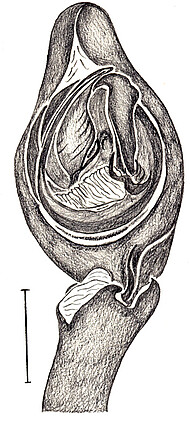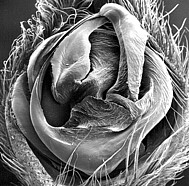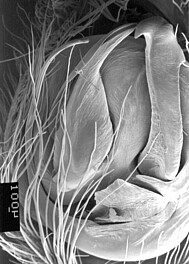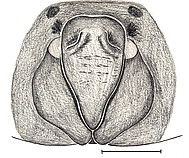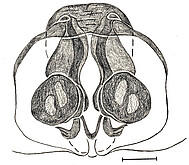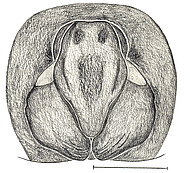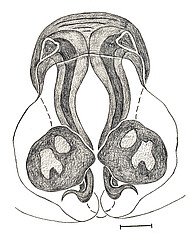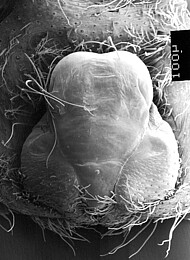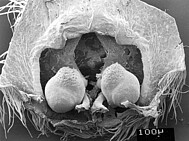Ancylometes rufus (♂,♀) (Walckenaer, 1837)
transfers and synonyms
Ctenus rufus Walckenaer, 1837; Roewer 1954; Bonnet 1956
Ctenus fuscus Walckenaer, 1837; Roewer 1954; Bonnet 1956
Ctenus giganteus Taczanowski, 1873; Roewer 1954; Bonnet 1956
Ctenus bimaculatus Taczanowski, 1873; Roewer 1954; Bonnet 1956
Leptoctenus tenkatei Hasselt, 1889
Lycoctenus brunneus Pickard-Cambridge, 1897; Strand 1907
Lycoctenus gigas Pickard-Cambridge, 1897
Lycoctenus demerarensis Pickard-Cambridge, 1897
Ancylometes gigas: Simon 1898; Roewer 1954; Bonnet 1955; Bernarde et al. 1999
Lycoctenus saraensis Strand, 1909
Ancylometes brunneus: Petrunkevitch 1911
Ctenus tenkatei: Petrunkevitch 1911; Roewer 1954; Bonnet 1956
Ancylometes demerarensis: Petrunkevitch 1911; Roewer 1954; Bonnet 1955
Lycoctenus paraensis Strand, 1915
Ancylometes pindareensis Mello-Leitão, 1920; Roewer 1954
Ctenus juruensis Mello-Leitão, 1922; Roewer 1954; Bonnet 1956
Ctenus striolatus Mello-Leitão, 1922; Roewer 1954; Bonnet 1956
Ancylometes pindareannus Mello-Leitão, 1924 (female holotype with same data as A. pindareensis); Roewer 1954 (objective synonym of A. pindareensis)
Ctenus xerophilus Mello-Leitão, 1936; Roewer 1954; Bonnet 1956
Lycoctenus titanus Caporiacco, 1947; 1948
Ancylometes giganteus: Caporiacco 1948
Ancylometes bimaculatus: Caporiacco 1948
Ancylometes titanus: Roewer 1954
Ancylometes saraensis: Roewer 1954; Bonnet 1955
Ancylometes paraensis: Bonnet 1955
Ancylometes pindareanus: Bonnet 1955
removed from synonymy
misidentifications
Ancylometes vulpes Bertkau: Petrunkevitch 1910
distribution
Rain forests of the Amazon basin and the Atlantic coast of Brazil.
description male
(specimen deposited at SMNK 306):
Prosoma dark brown with broad marginal white bands. Legs and abdomen dark brown, venter lighter. Palpal tibia with curved ventral and black lateral apophysis. Embolus broad at base flanked by triangular membranous lobe, then describing a semicircle, ending filiform beneath apex of cymbium, median part embedded in broad wing-like conductor. Opposite to conductor a slightly curved, relatively long hammer-like median apophysis.
Chelicerae with 3 promarginal and 4 retromarginal teeth, third small.
Measurements: Total length 35.0. Prosoma 18.8 long, 16.0 wide. Clypeus 1.5. Eye diameters and interdistances: AME 0.7, ALE 0.45, PME 0.7, PLE 0.7; AME-AME 0.4, AME-ALE 0.55, PME-PME 0.25, PME-PLE 0.35, AME-PLE 1.2, AME-PME 0.3, MOQ length 1.65, front width 1.8, back width 1.3.
Legs: I-femur 21.0/ patella 9.0/ tibia 21.0/ metatarsus 24.0/ tarsus 10.0/ total 87.0; II- 21.0/ 9.0/ 19.5/ 22.0/ 9.5/ 82.0; III- 18.0/ 8.0/ 17.0/ 21.0/ 9.0/ 72.0; IV- 23.0/ 9.0/ 21.0/ 24.0/ 10.5/ 90.0. Cymbium 7.0 long, 4.0 wide, median apophysis 2.5 long.
Leg spination: Femora I-II v0, p1-1-1-1, r1-1-1, d1-1-1; III v0, p1-1-1-1-(1), r1-1-1-1, d1-1-1; IV v0, p1-1-1-(1), r1-1-1-1, d1-1-1; patellae I-IV v0, p1, r1; tibiae I-II v2-2-2-2, p1-1, r1-1-1, d1-1-1; III-IV v2-2-2, p1-1, r1-1, d(1)-1-1-1; metatarsi I-II v2-2-1, p1-1, r1-1, d0; III v1-1-1-1-2, p1-1-1-1, r1-1-1, d1-1; IV v1-1-1-1-1-1-1-2, p1-1-1-1, r1-1-1, d1-1; tarsi III-IV v14-16. Palpal femora p1, r1, d1-1-2; patellae p1; tibiae p1, d2.
Coloration of living specimens (from Reserva Ducke, Manaus): Prosoma of adult males dark brown, with broad creamy white to white lateral bands. Small white lines above PME and cheliceral base white. Abdomen dark brown dorsally, lighter ventrally. Legs all dark, with white lines laterally on femora and sometimes white spots dorsally on femora and patellae.
description female
(specimen deposited at SMNK 306):
Whole body dark brown, legs spotted grey. Chelicerae with 3 promarginal and 4 retromarginal teeth (third small).
Epigynal median plate flat, triangular with rounded edges, without any projection. Epigynal openings anterior-laterally, copulatory ducts sigmoid, entering circular spermathecae from ventral. Spermathecae nearly touching each other.
Measurements: Total length 35.0. Prosoma 18.3 long, 15.2 wide. Clypeus 1.1. Eye diameters and interdistances: AME 0.6, ALE 0.35, PME 0.6, PLE 0.75; AME-AME 0.7, AME-ALE 0.6, PME-PME 0.5, PME-PLE 1.0, AME-PLE 1.5, AME-PME 0.5, MOQ length 1.8, front width 1.9, back width 1.7. Epigynal median plate 2.4 long, 1.3 wide.
Legs: I-femur 16.0/ patella 8.0/ tibia 22.0/ metatarsus 12.0/ tarsus 6.5/ total 56.0; II- 15.0/ 8.0/ 13.0/ 11.0/ 6.0/ 52.0; III- 13.0/ 6.0/ 11.0/ 12.0/ 6.0/ 49.0; IV- 16.0/ 6.5/ 16.0/ 18.0/ 6.5/ 63.0.
Leg spination: Femora I-II v0, p1-1-1, r1-1-1, d1-1-1; III-IV v0, p1-1-1-1, r1-1-1-1, d1-1-1; tibiae I-II v2-2-2-2, p0, r0, d0; III-IV v2-2-2, p1-1, r1-1, d1-1-1; metatarsi I-II v0, p0, r0, d0; III v2-2-2; IV v1-1-1-1-1-1-1-2; III-IV p1-1-1, r1-1-1, d1-1-1-2; tarsi III-IV v12-16. Palpal femora p1, r1, d1-1-2; patellae p1; tibiae p2, rd1-1; tarsi p2-1, r1-1.
Coloration of living specimens (from Reserva Ducke, Manaus): Females much lighter than males, prosoma and abdomen uniformly brown, legs and chelicerae appearing washed out by dark or yellow irregular spots. Larger juveniles often bright reddish dorsally.
references
- Gasnier T.R., Azevedo C.S., Torres-Sanchez M.P., Höfer H. (2002):
-
Adult size of eight hunting spider species in central Amazonia: temporal variations and sexual dimorphisms.
Journal of Arachnology 30

- Azevedo C.S. (2000):
- Ecologia de Ancylometes gigas (Pickard-Cambridge, 1897) (Araneae: Pisauridae), uma aranha errante que vive próximo a corpos de água em uma floresta tropical úmida. Master thesis, unpublished , University Manaus, INPA/FUA
- Höfer H., Brescovit AD. (2000):
- A revision of the Neotropical spider genus Ancylometes Bertkau (Araneae: Pisauridae). Insect Systematics & Evolution 31
- Höfer H., Beck L. (1996):
- Die Spinnentierfauna des Regenwaldreservats 'Reserva Ducke' in Zentralamazonien II. Natur und Museum 126


